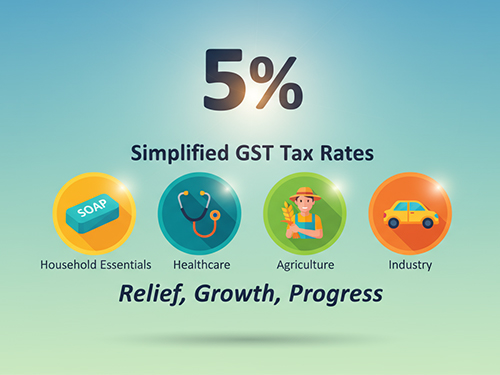GST 2.0: A Citizen-Centric Tax Revolution for a New India

On 15th August 2025, from the ramparts of the Red Fort, Prime Minister Shri Narendra Modi announced the dawn of next-generation GST reforms—a landmark step in India’s economic journey. The reforms, now approved by the GST Council, are designed with one clear mission: to simplify taxation, empower citizens, and fuel inclusive growth.
The Spirit of GST 2.0:
These reforms are not just about numbers or slabs; they are about people. Every decision reflects a citizen-first approach—easing the burden on households, strengthening small businesses, supporting farmers, encouraging insurance coverage, and boosting industries that drive India’s economy.
Key Highlights at a Glance

Simplified Tax Structure – From four tiers to a Simple Tax:
- 5% Merit Rate for essentials.
- 18% Standard Rate for most goods and services.
- 40% De-merit Rate for luxury and sin goods.
Relief for the Common Man – Household items like hair oil, soaps, bicycles, toothpaste, namkeen, noodles, and more are now taxed at just 5%. Essentials like roti, paneer, UHT milk, and medicines are GST-free.
Healthcare for All – All life and health insurance policies are exempted from GST, along with huge tax cuts on medicines, medical equipment, and life-saving drugs.
Support to Farmers & Labour-Intensive Industries – Agricultural machinery, handicrafts, textiles, fertilizers, and renewable energy devices now attract just 5% GST.
Boost for Industry & Growth – Cement, autos, buses, trucks, and consumer durables like ACs, TVs, and dishwashers now taxed at 18% instead of 28%. Auto parts were made uniform at 18% to simplify compliance.
Ease of Doing Business – Inverted duty structures corrected in textiles and fertilizers; GST Appellate Tribunal (GSTAT) to be operational by the end of 2025.
Why It Matters
- For citizens: Everyday life gets more affordable, healthcare becomes accessible, and insurance coverage expands.
- For farmers & small traders: Inputs and machinery become cheaper, helping them grow faster.
- For businesses: Simplification and rationalization cut compliance burdens and unlock growth potential.
- For the economy: GST 2.0 fuels demand, drives productivity, and strengthens India’s position as a global growth engine.

GST 2.0 is more than a tax reform—it is a citizen’s reform. By placing the common man at the center of economic policy, India takes a bold step toward a future where growth, affordability, and fairness walk hand in hand.
This is not just the next chapter in taxation. It is the story of a new India—resilient, inclusive, and ready to rise higher.





Leave a Reply